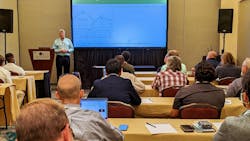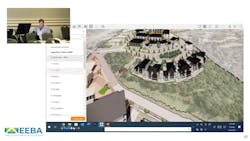Last September, Utopia editors attended the annual EEBA High Performance Home Summit in Scottsdale, Ariz. The hybrid event was attended by over 400 building professionals and 50+ virtual attendees. From exhibitors to education sessions, a few recurring topics seemed to make their way into everything.
Here are a few of our biggest takeaways.
EEBA SUMMIT TAKEAWAYS
Decarbonization is key
Over 30% of sessions at the EEBA Summit featured decarbonization as the main item of discussion. Whether it’s embodied or operational carbon, builders and industry professionals are narrowing down the best ways to decrease carbon emissions.
The new imperative in the U.S. is to reduce carbon emissions by 26% to 28% in the next three years. Then, to net zero carbon by 2050. Builders already have a housing crisis to deal with—what type of carbon are they supposed to focus on first?
According to Chris Magwood, manager, Carbon-Free Buildings, at RMI, there are a few areas where incremental change can help builders bring down their carbon footprint. Some simple initiatives that builders can adopt include specifying a low-carbon concrete mix, moving to an insulation product that’s the best in its category, and finding the best available flooring materials.
Another thing to keep an eye out for is full-electric construction. Some, like Peter Turnbull, independent energy consultant, predict that full-electric new construction will dominate dual fuel by 2030. If that’s the case, then carbon emissions from the construction industry will decrease significantly, aiding in the country’s goal of reducing greenhouse gas emissions.
Health and wellness wins
Whether its indoor air quality or biophilic design, buyers and builders are putting an emphasis on health and wellness. In fact, buyers rank their desire for healthy homes only second to energy-efficient ones.
Special research labs have even been made to test the impacts of indoor environments on health and well-being. Well Living Lab, in collaboration with Marvin, is developing a smart, connected test home to study how changes in the indoor environment affect human subjects.
This includes manipulating conditions such as air quality, temperature, lighting, and biophilic elements to determine how they affect human health and performance. All of this, to learn what factors influence our health and wellness in our homes.
Digitized homebuilding/buying grows
From digital twins to virtual sales, more and more companies are utilizing the technological advancements of the 21st century.
Software companies like Digibilt offer computer users to take a first-person tour through fully-furnished homes. Digibilt uses virtual models, text messages, and patent-pending software to modernize home construction.
Digitizing parts of the homebuilding process allows for a streamlined workflow, a safety net for design errors, and a productive way to use labor. (And in this era of labor shortages, the digitization of homebuilding could be a worthwhile endeavor).
But it’s not just the building process that has turned digital. Some real estate companies are utilizing the “metaverse” to virtually sell homes.
A Realtor.com survey found virtual tours to be the leading technology home shoppers find most helpful. And for buyers moving from other parts of the country, access to online tours and floor plans can help them make a purchase from afar and avoid risking losing a home site they love.
For prospective buyers, virtual touring not only helps build interest and excitement, but the virtual homebuilding sales team can market floor plans that haven’t been built yet, or show layout options not seen in the model.


